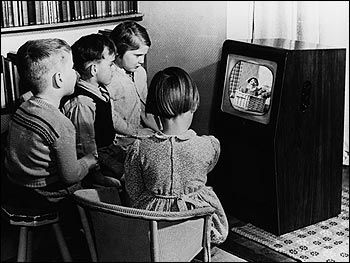Do you dream in? If so, the chances are you are over 55 and were brought up watching a monochrome television set.
New research suggests that the type of television you watched as a child has a profound effect on the colour of your dreams.
While almost all under 25s dream in colour, thousands of over 55s, all of whom were brought up with black and white sets, often dream in monchrome – even now.
The findings suggest that the moment when Dorothy passes out of monochrome Kansas and awakes in Technicolor Oz may have had more significance for our subconscious than we literally ever dreamed of.
Eva Murzyn, a psychology student at Dundee University who carried out the study, said: “It is a fascinating hypothesis.
“It suggests there could be a critical period in our childhood when watching films has a big impact on the way dreams are formed.
“What is even more interesting is that before the advent of black and white television all the evidence suggests we were dreaming in colour.”
Research from 1915 through to the 1950s suggested that the vast majority of dreams are in black and white but the tide turned in the sixties, and later results suggested that up to 83 per cent of dreams contain some colour.
Since this period also marked the transition between black-and-white film and TV and widespread Technicolor, an obvious explanation was that the media had been priming the subjects’ dreams.
However it was always controversial and differences between the studies prevented the researchers from drawing any firm conclusions.
But now Miss Murzyn believes she has proved the link. She re-looked at the old studies and combined them with a survey of her own of more 60 people, half of which were over 55 and half of which were under 25.
She asked the volunteers to answer a questionnaire on the colour of their dreams and their childhood exposure to film and TV.
The subjects then recorded different aspects of their dreams in a diary every morning.
Miss Murzyn found there was no significant difference between results drawn from the questionnaires and the dream diaries – thus proving that the previous studies were comparable.
She then analysed her own data to find out whether an early exposure to black-and-white TV could still have a lasting effect on her subjects’ dreams, 40 years later.
Only 4.4 per cent of the under-25s’ dreams were black and white. The over-55s who had had access to colour TV and film during their childhood also reported a very low proportion of just 7.3 per cent.
But the over-55s who had only had access to black-and-white media reported dreaming in black and white roughly a quarter of the time.
Even though they would have spent only a few hours a day watching TV or films, their attention and emotional engagement would have been heightened during this time, leaving a deeper imprint on their mind, Miss Murzyn told the New Scientist.
“The crucial time is between three and 10 when we all begin to have the ability to dream,” she said.
“Television and films which by their very nature are interesting and emotionally engaging and even dreamlike. So when you dream you may copy what you have seen on the screen.
“I have even had a computer game player who dreams as if he is in front of a computer screen.”
Miss Murzyn concedes it’s still impossible to verify whether the dreams are actually in black-and-white, or whether media exposure somehow alters the way the mind reconstructs the dreams once we wake.
Source : http://boingboing.net/2008/10/22/people-over-55-dream.html








Comments are closed.